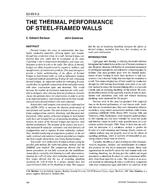Description
Attempts to provide a better understanding of the effects of thermal bridges in steel-framed walls, as well as information leading to improved methods of predicting R-value of walls containing thermal bridges. An improved method for estimating R-value would allow an equitable comparison of thermal performance with other construction types and materials. This would increase the number of alternative materials for walls available to designers, thus allowing them the freedom to correctly choose the optimum choice for construction. In order to arrive at an improved method, experimental data on the heat transfer characteristics of steel-framed walls were collected. Twenty-three wall samples were tested in a calibrated hot box (ASTM C976) to measure the thermal performance of steel-framed wall systems. The tests included an array of stud frame configurations, exterior sheathing, and glass fibre batt insulations, Other studies of thermal bridging in steel-framed walls have not included the use of insulating sheathing, which reduces the extent of the thermal bridges and improves total thermal performance. Provides measured R-values for commonly used steel-framed wall configurations and to improve R-value estimating methods. Also, detailed monitoring of temperature gradients in the test walls combined with numerical analysis provided new insights into heat transfer phenomena concerning thermal bridges. Test results were compared to R-value estimates using the parallel path method, the isothermal planes method, and the ASHRAE zone method. The comparison showed that the known procedures do not fully account for the multidimensional effects created by steel framing in a wall, often underestimating the wall’s R-value when insulating sheathing is used. Test results showed that the use of insulating sheathing increased the wall R-value by a greater amount than that expected based solely on the sheathing R-value. This suggests that the use of insulating sheathing mitigates the effects of thermal bridges, including heat loss, dust streaking on the studs, and condensation.
KEYWORDS: year 1995, heat flow, calculating, thermal bridges, walls, steel, buildings, heat loss, condensation, dust, thermal resistance, comparing, thermal insulation, measuring
Citation: Symposium, ASHRAE Trans. 1995, Vol.101, Part 2
Product Details
- Published:
- 1995
- File Size:
- 1 file , 1.5 MB
- Product Code(s):
- D-17166




